- Home
- Rudy Rucker
Spacetime Donuts Page 6
Spacetime Donuts Read online
Page 6
"Just make sure it's really bizarre," Turner cautioned. "The Professor keeps telling me that he doesn't want his invention to be used as a tool of fascist oppression or beer-fart consumerism. Like, he didn't spend twenty years getting it together just to shrink turbines for shipping, or enlarge some lame dude's ass for his hemorrhoid examination. He was counting on Oily Allie to do something really dangerous with it. Like she says, Freedom is Danger."
"Did he already know that it's safe to use the VFG on people?" Vernor asked. "I mean, before he gave it to you?"
"On paper. He wasn't going to turn it on himself until someone else tried it, though. Freedom is also staying alive, y'know. For him anyway. I figure the reason he gave me the VFG was that if anyone was going to turn it on themself it'd be me." The shot was wearing off and Mick was beginning to look less alert. "I was gonna go tell him about how things are going, but I've been in a bag. Just couldn't get out of it, you know, waiting for something to turn up."
"Here I am," Vernor said.
Mick patted him on the shoulder. "It's good to see you." His speech was beginning to slur. "Hey, Waxy, gimme another bang before I fade."
Another injection and Turner was ready for a civilized evening. "I heard Moto-O was supposed to build Phizwhiz a soul to replace the Angels," he said. "Is that true?"
"Yeah," Vernor answered. "He was telling me about his idea a couple of weeks before the big bust. I don't think it worked, though. It's not crazy enough. There might be a way—"
"Well, where is that pimp," Turner interrupted. "It's thanks to him that the Angels are gone."
"He didn't know that was going to happen. Anyway he's probably in jail by now. He had until last month to finish the job . . . There hasn't been any big talk about a new Phizwhiz has there?"
Turner was feeling around in his pocket. "No, I don't think so. Look, as long as we're going to go to Kurtowski's lab tomorrow morning, we might as well use up what's left of the ZZ-74."
They split seven of the clear gelatin capsules—a hefty dose; although it proved not to be that easy to sort the ZZ-74's effect out from the rest of the evening's excitement.
The high point came when they played Zappa's classic cut, "Stink-Foot", with the VFG turned up to full warp. The room around them wagged and twisted like a melting plastic shoebox, but in full synchronization with the steady beat of the song.
The bent notes rippled in new but inevitable chord progressions, as Zappa's happy voice talked and sang, telling a story about a talking dog and a disbelieving man.
"You can't say that," objected the man in the song...and the dog responded, "I do it all the time. Ain't this boogie a mess?"
Chapter 8: Trips
Vernor slept upstairs at Waxy's. The room was equipped with a pornographic Hollowcaster. It was nice having a beautiful naked girl posing herself for him, right on his bed, but it would have been a lot nicer if she had been somewhat less ethereal. He was stoned enough to attempt mounting her, and he just about broke his cock with his first mighty thrust through her and into his mattress. His last thought was one of anger with himself for not yet having called Alice to patch things up.
The next morning he showered, dressed, and went downstairs for breakfast. "What's the menu today, Waxy?"
"Green. How do you want it?"
"With a glass of beer." Waxy filled a bowl with lumpy green paste from the wall-tap, and drew a glass of beer at the bar. Green was Vernor's favorite color Dreamfood. They called it Dreamfood because all the Dreamers ate it. It came free for anyone in Dreamtown. A different color-coded flavor for every meal. Green tasted like scrambled eggs with bits of toast and bacon. If you were going to eat it, you didn't ask what it was.
"What ever happened to Mick last night?" Vernor asked between mouthfuls.
Waxy jerked his head towards the closest booth. "He took a hit of Three-way and went in there to ride it out."
Vernor finished his breakfast and went over to the booth. Three-way was a particularly vicious combination of a stimulant, a depressant, and a hallucinogen—all highly synthetic. But Vernor was not prepared for the sight which greeted him when he opened the door of Turner's booth.
Mick's torso was bloated to twice it's normal size, his arms and legs were twisted at hideous, unnatural angles, and half of his head seemed to have withered. He looked like a painting by Francis Bacon.
Vernor watched with mounting horror as the torso began to quiver, jelly-like, and the ruined head turned slowly toward him, the normal half slowly shrinking to match the other half. Unbelievably the apple-like head spoke, "You look really fucked, Vernor." Of course! It was the VFG.
Vernor exhaled. "Please turn that thing off, Mick." A click and Turner zipped back to his usual shape.
"Never felt a thing," he remarked. "I just felt normal. It was everything else looked funny." Relativity . . . halve your size or double the size of everything except you . . . same difference. The Virtual Field was safe because it distorted space without inducing any curvature of the time axis. No time curvature meant no forces—just a nice safe rescaling of the size scales.
Once again, the fascination of weird science was drawing Vernor in. Turner breakfasted on a handful of leapers and they set off for the Eastside. The City was some thirty miles in diameter, but there was a rapid underground transportation system of moving sidewalks in the walktubes.
They took the stairs down to the Eastbound tube. There was a thirty yard river of people flowing past, borne along by the small spinning rollers which made up the surface of the moving sidewalk. The people near the edges were moving no faster than a walk, so that it was possible to step on and off the moving sidewalk without difficulty. As you moved towards the center of the tube, however, the speed of the rollers gradually increased until you were doing about fifty miles per hour. Each roller was quite small, about an inch wide and a quarter inch in diameter, so the ride was smooth.
Kurtowski's laboratory was in the basement of a plastics factory, not far from the walktube exit which Mick and Vernor used. After Mick had pounded on the door and hollered for awhile, the door opened.
The Professor greeted them warmly. "You have good news?" he smiled. Mick shrank Vernor's head and then let it snap back to normal. "As I thought," Kurtowski observed. "A singularity-free diffeomorphism never hurt anyone." He turned to Vernor, "And you, pinhead, who are you?"
"Vernor Maxwell."
"Ah, ja, poor Andy talked about you once. You have studied my early work I think?"
Vernor nodded. "Mick was showing me that VFG. I sort of had a good idea for something to do with it." He felt nervous about telling his "good ideas" to so great a thinker.
"Let me show you around the lab, and then we'll talk."
Apparently the basement was no longer used by the automated factory above them. It was a huge room, with machines and workbenches scattered all around it; books everywhere, usually open to some valued passage; mounds of notes; used foodtubes and dirty clothes; and crates and crates of supplies for Professor Kurtowski and his machines.
An area near the far wall was the present nucleus. The density of books and supply crates increased as one approached it, and many cables led there. This was where Kurtowski was building his new large-size Virtual Field Generator.
"Ja," he said as they approached the main work area. "You are walking through my life here. This," he slapped a loaded workbench affectionately, "is where I tamed my little neutrinos. Over here," a panel of dials loomed over them, "was my listening machine." He stopped. "Listen, Vernor."
He handed Vernor a pair of earphones and began adjusting controls on the panel. A rapid, articulated sound chirped from the earphones. Vernor put them on.
There it was before him. But what was it? Laughable to force its magnificence into human words, human concepts . . . only float closer, closer, ahhhhh. Warmth and light enveloped him, and his body outline began a dissolve. He was a cloud. There was clear ether in between his particles . . . the particles were thoughts, and the spa
ce between his thoughts was black was white . . . no space, no thoughts, inside, outside—CLICK.
Someone had turned the phones off. The energy field in front of Vernor's eyes arranged itself into the basement of a plastics factory, into Mick Turner's face. Kurtowski explained, "That's the center of the galaxy, Vernor. The treble is the neutrino flux and the bass is the gravity waves. Pulsars and singularities on miscellaneous percussion." He smiled. "When I use it I generally set a timer to turn it off—"
"Put me down for a half hour," Mick said, taking the earphones. He tapped his head, "I'm down to summer reruns in here." The Professor tuned the machine in again and Turner sat down with a happy expression, his eyes open but not looking.
"I get a lot of good ideas listening to that," Kurtowski continued. "The problem is remembering them, eh?" He led Vernor on through the lab. "Controlling the virtual electron field's interaction with the neutrino flux was all I had to do to get my machine going. It was not so very hard once I realized that neutrinos don't exist."
"How do you mean?" Vernor asked.
"It's like the coast. There is a coast because there is land and ocean. Neutrinos are the coast between the regular particles and the tachyons. There is no thing you can point to and say, this is part of the coast. When you point, it is at land or at water. The neutrino flux is just . . . the erosion of regular particles by tachyons."
"Tachyons? The particles that go faster than light? I thought that since they're undetectable they don't really exist."
"Exist for who, Vernor?"
He didn't attempt an answer. They had left Mick Turner with the earphones and were now in the main work area. There were several lights, littered workbenches, and two roughly conical assemblages, similar in appearance and separated by about ten feet. Large wave guides led to the cones—apparently they were powered by radiation from the hulking transformer behind the workbench, which in turn received its power through thick bus bars leading up through the ceiling into the humming factory above.
Professor Kurtowski placed a chair in the space between the two parts of the Virtual Field Generator. On the chair he put a large clock with a second hand. "Watch closely," he said, turning on the machine.
The power switch was a dial. As the intensity of the field was turned up the chair began to be affected. The top of the chair's back was approximately level with the poles on the top of the VFG cones. The effects were strongest there. In a few seconds the back of the chair had shrunk to the size of a ping-pong paddle. The shrinking effect was weaker down by the chair's legs, so the whole chair seemed to taper towards its top. The floor under the legs bulged upwards, drawn by the shrinkage of space, and the VFG cones seemed to lean slightly towards the chair.
Kurtowski upped the power. Now the floor had bulged several feet, holding up a tiny chair which seemed to taper to a point. The cones were definitely leaning over.
Another power boost and the chair was all but invisible between the almost touching points of the severely distorted cones. "Now the other way," the Professor said, dialing back down to zero power. "Did you notice the clock?"
"Was it going faster?" Vernor asked. "It seemed like the smaller it got, the faster it went."
"Right, Vernor, conservation of perceived momentum, eh?" The Professor switched the polarity of the machine and began turning the power up again. Now the back of the chair was growing, the legs as well, but less drastically. The chair began to resemble a spike balanced on a depression in the floor. The cones leaned away, as if to make room, as the chair grew to some twenty feet in size.
Somehow the space between the VFG cones seemed to be taking up most of the basement, and the enormous chair was almost overhead. The second hand of the clock on the chair was crawling, its motion barely perceptible.
The change in time-scale surprised Vernor, but it was, after all, to be expected. Big things are always slower than little things—watch an elephant and a dog scratching themselves. Less metaphorically, when you shrink a watch, it's going to go faster if no angular momentum is to be lost. Professor Kurtowski turned the machine off.
"So what is it good for, Vernor? You have, I think, a project?"
Vernor collected his thoughts. "How small can you make something with the Virtual Field?"
"There is no obvious limit. At first I was afraid that a great enough shrinkage might initiate gravitational collapse to singularity, but, as the local densities of the objects in the field do not actually change, this problem does not arise." The Professor was in good form.
"So you think you could shrink forever?" Vernor asked.
"This is not entirely clear. Quantum mechanics seems to say that when you've shrunk to a certain scale, you have to stop. But maybe they're wrong. Tell me what you have in mind."
This was it. The idea Vernor had been nursing ever since his vision in the tree came tumbling out. "Professor, I think that if you shrink something enough it gets as big as a galaxy. I think that just as going West long enough ends with coming back from the East, shrinking far enough below normal size ends with coming back from larger than normal size." Kurtowski looked interested and Vernor continued.
"The size scale extends out in both directions. Going down we have people, cells, molecules, atoms, elementary particles, and so on. Going up we have people, societies, planets, solar systems, star clusters, galaxies, groups of galaxies, etcetera. My idea is that maybe this size line is actually a huge circle. That is, maybe if you go three steps below electrons and three steps above clusters of galaxies you get the same thing. Usually the largest thing of all is called Universe, and Leibniz has called the smallest thing of all Monad. I suggest that Universe equals Monad. If you break anything down far enough, you'll find the whole Universe inside each of its particles." Vernor stopped and drew a breath.
"This is a very strange idea," Professor Kurtowski said, lighting a cigarette. He was so old-school that he was still into tobacco. "A bizarre idea. In this world of Circular Scale you have no matter; this is nice, yes?"
Vernor smiled. "The problem of matter is answered by the Circular Scale Theory. You take a rock and grind it into dust, grind the dust into atoms, smash the atoms into electrons and nucleons, break these into quarks and resonances, do it five more times and notice that what you're looking at is galaxies . . . which split into stars and planets, and the planets split into rocks . . . one of which is the same rock you started with. And you can go around again without ever encountering any solid matter—just form and structure."
"Ja, ja, very nice," Kurtowski smiled. "And you want to make the trip around the Circular Scale with my Virtual Field Generator, eh Vernor?"
Vernor gulped. "Actually, I was thinking more in terms of sending a piece of apparatus around. Like maybe a camera."
"If I can risk my beautiful machine, you can risk your neck, Mr. Maxwell, After all, Mick has determined that the field is not harmful. It should be relatively safe for you to make this trip." Kurtowski paused a moment. "But there are difficulties. There will be some serious difficulties."
Mick Turner, back from the galactic center, had been listening to the last part of their conversation. He grinned and slapped Vernor on the back. "The incredible shrinking man," he said.
Chapter 9: ZZ-74
"Did you ever plug in with a girl, Mick?" Vernor asked Turner. They were dragging a heavy crate of synthequartz across Professor Kurtowski's laboratory floor. They had been living there for two weeks, helping to beef up and outfit the VFG for a trip through the place where zero equals infinity. Vernor couldn't decide if he wanted the machine to be ready for him or not. He liked this in-between time; for now he'd abandoned his dreams of Alice and had put normal life on hold.
"Sure," Turner drawled, "plenty of times. You get a piece of co-ax and run it from your socket to her socket and then you do it."
"Yeah, yeah," Vernor interrupted, "I know. But what's it feel like?"
"You never done that?" Turner asked in amazement.
"No, well, you know. I
just never did. And now I may never get a chance."
Mick laughed and shook his head. "If you get into it it's kind of hard to get sorted out after you come. One time I wanted to say something afterwards and it came out of her mouth. The words." He grunted with effort as they rocked the box over a thick cable in its path. "Once I met a chick who had a dual amplifier. You both plugged into the amp and it mixed the signals and sent 'em back triple intensity. Actually there was four of us plugged into the amp. It had these long coil-spring co-axes. You get so merged—it's a drag coming down. Just being in one body again."
Kurtowski looked up as they approached him. "Tomorrow is the day, boys." Indeed the machine looked ready. They had constructed a tensegrity sphere of molybdenum tubing and nyxon cables. The two VFG cones had been rebuilt and attached to the inside of the sphere at its North and South poles, with the cone points almost touching at the sphere's center. There was a band of power units along the equator of the sphere, with a space left for a seat and a control panel. All that remained was to encase the sphere in a film of the strong, transparent synthequartz and it would be a functioning scale-ship.
The idea was that the virtual field would fill the sphere, causing the whole thing to shrink—sphere, VFG cones, passenger and all. The passenger, Vernor in this case, would be able to control the rate and the direction of the size change.
They set to work putting the coating of synthequartz on the framework of molybdenum and nyxon. The sphere was constructed to have a certain natural elasticity so that it would not crack under possible irregular pressures. The purpose of sealing Vernor off from the space around him was so that he could continue to breath when the sphere and its contents had shrunk to a size smaller than an oxygen molecule. Without the containing skin of synthequartz, the air which shrank along with Vernor might drift out of the field and expand to a non-usable size—after all, you can't breathe basketballs.

 Million Mile Road Trip
Million Mile Road Trip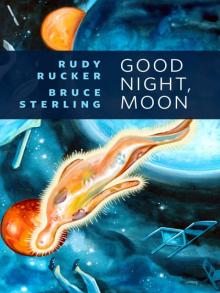 Good Night, Moon
Good Night, Moon Transreal Trilogy: Secret of Life, White Light, Saucer Wisdom
Transreal Trilogy: Secret of Life, White Light, Saucer Wisdom Complete Stories
Complete Stories The Sex Sphere
The Sex Sphere Surfing the Gnarl
Surfing the Gnarl Software
Software Mathematicians in Love
Mathematicians in Love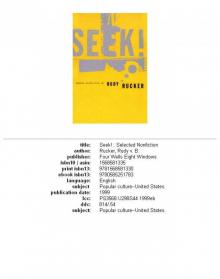 Seek!: Selected Nonfiction
Seek!: Selected Nonfiction The Secret of Life
The Secret of Life The Hacker and the Ants
The Hacker and the Ants Postsingular
Postsingular Spaceland
Spaceland Transreal Cyberpunk
Transreal Cyberpunk Sex Sphere
Sex Sphere Spacetime Donuts
Spacetime Donuts Freeware
Freeware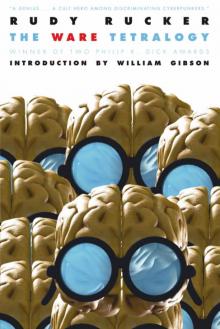 The Ware Tetralogy
The Ware Tetralogy Frek and the Elixir
Frek and the Elixir Junk DNA
Junk DNA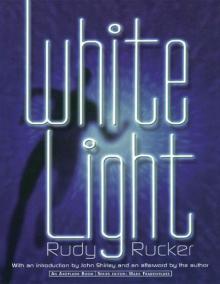 White Light (Axoplasm Books)
White Light (Axoplasm Books) Nested Scrolls
Nested Scrolls Inside Out
Inside Out Where the Lost Things Are
Where the Lost Things Are Mad Professor
Mad Professor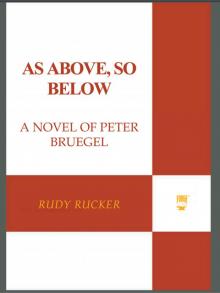 As Above, So Below
As Above, So Below Realware
Realware Jim and the Flims
Jim and the Flims Master of Space and Time
Master of Space and Time The Big Aha
The Big Aha Hylozoic
Hylozoic